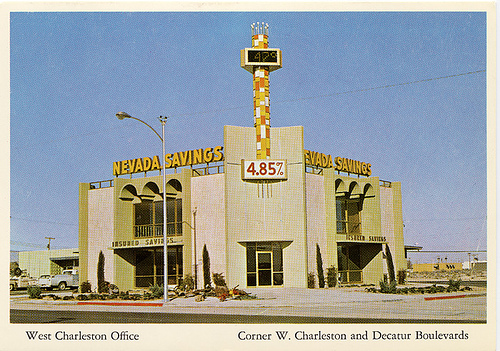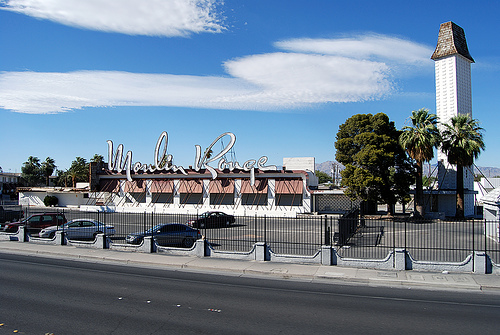Entries in Preservation Issues (114)
The Frontier Sign Comes Down

Steve Wynn put up the money to have the iconic Frontier sign taken down so that the sign would not block the view of his latest hotel-casino tower, Encore. Wynn considered the sign an "eyesore".
The sign, a 186-feet tall, was taken down in sections. We are still trying to confirm if the sign will be donated to the Neon Museum. From what we understand, that decision has yet to be made.
The sign was one of the oldest still standing on the famed Las Vegas Strip and harkened back to the days when the giant neon signs could be seen down the highway for miles. A combination of flicker bulbs and neon, the sign was designed by Bill Clark of Ad-Art. The sign contained more than a mile of flourescent tubing, a mile and a half of neon and more than 23,000 light bulbs. The 30- foot tall F at the top of the sign rotated on a specially built mechanism. An enormous caisson was installed to keep the sign from toppling over in a Las Vegas windstorm.
For more information on the history of the Frontier Hotel:
http://classiclasvegas.squarespace.com/display/ShowJournal?moduleId=1093544¤tPage=4
Special thanks to RoadsidePictures for letting us use this image.
Friends of Classic Las Vegas Holiday Meeting

Join us for our annual FCLV General Meeting and Holiday party.
Our special guest will be historian Mark Hall-Patton who will give a talk on the history of street names around the Las Vegas Valley. So if you're wondering who streets like Bracken, Campbell and others were named for, join us on Sunday Dec. 14th.
FCLV General Meeting and Holiday Party
December 14th
2:00 pm
The meeting is being hosted by FCLV member Marge Rea at her home which will be decorated for the holidays.
Please contact me to get the address and directions.
We hope to see you there!
Walter Zick - Mid-Century Modern Las Vegas Architect

The Mint Hotel designed by Walter Zick and Harris Sharp
He was one of the most prolific architects in Las Vegas. Walter Zick, along with his partner Harris Sharp, designed some of the coolest mid-century modern buildings in Southern Nevada. His best known design is probably also the most-beloved, the fabulous Mint Hotel. It's design fulfilled the optimistic potential that was pervasive across America in the late 1950s and the early 1960s. In that canyon of neon called Glitter Gulch, the Mint sat shoulder to shoulder with fanciful facades that depicted the Barbary Coast (The Golden Nugget), the Wild West (The original California Club) and San Francisco (The Golden Gate).
Wayne McAllister's design of the Fremont Hotel may have been the first mid-century modern casino on Fremont Street but Zick and Sharpe saw that design and raised the stakes. Working with YESCO's top designers, Kermit Wayne and Hermon Boergne, the facade of the Mint was one of the first to explore the three dimensional aspects of neon. It's eye-poping pink and white neon took your breath away.
If the Mint was all that Zick and Sharp had designed in Las Vegas that would be enough. But thanks to Friends of Classic Las Vegas commercial chair Mary Martinez and our favorite downtown neighborhood blogger, Jack LeVine, I have been given a disc of images and information on the life and works of Walter Zick. His family is trying to get a school named for him and though their initial request was turned down, we are thrilled to be joining with VeryVintageVegas to help spotlight Zick's accomplishments and keep the idea of a school named in his honor alive.
Walter Zick designed more than just casinos and hotels. I grew up in Charleston Heights which sports many of the schools and commercial buildings that he designed. I am familiar with Hyde Park Junior High School which was the first air-conditioned school in the nation. My brother was born at Southern Nevada Hospital in the mid-1960s when it sported a Zick and Sharp mid-century facade. I attended junior high school at Garside, which they designed. I attended high school at Ed. W. Clark High School which was designed by Zick and Sharp. They designed both Western High School and Valley High School, both cross-town rivals of Clark. We attended football games every Friday night at the Sam Boyd Silver Bowl, again designed by Zick and Sharp.
After I graduated in 1975, I attended UNLV and had a Shakespeare class in the Humanities Building that Zick designed. The Maude Frazier Building, the first building on the campus when it opened in 1958 was designed by them.
We did our banking at the corner of Charleston and Decatur at the Bank of Las Vegas and the First National Bank of Nevada both designed by Zick and Sharp. The Foley Federal Building which was built next to the 5th Street Grammar School where I attended kindergarten was also designed by them. The Clark County Courthouse near the Foley Federal Building is their design.
I remember the Nevada Savings and Loan Headquarters, the Nevada State Bank near then-popular Spanish Oaks, Western Airlines terminal, the Westgate Shopping Center, the YMCA addition.
In addition to the Mint, he designed the Bird Cage Casino which sat just west of the Mint and was ultimately annexed by the hotel and he and Sharp designed the famous "eyebrow" addition. They helped complete Wilbur Clark's Desert Inn, had a hand in the remodel of the El Rancho Vegas, designed the first integrated hotel and casino, the Moulin Rouge as well as the Union Plaza and many more.
He also designed residential homes for some of the biggest movers and shakers in Las Vegas including Benny Binion, the Cashman family, Marcus Daly (whose rec room included a below ground bomb shelter, a bowling alley and a movie theater), architect Bill Moore's house, Mayme Stocker's house on Bracken Avenue, Joseph Switzer's house and Ted Weins as well.
We'll hopefully have more on Walter Zick in the days and weeks ahead so keep an eye out here!

Destroyed for a Walgreens.

The Moulin Rouge (with signage by Betty Willis) before the fire of 2003.
Special thanks to RoadsidePictures for letting use this image.
Special thanks to the family of Walter Zick for letting us highlight his life.
Special thanks to Mary Martinez and Jack LeVine for the disc!
Las Vegas High School gets a make-over

 Uncle Jack at VeryVintageVegas.com supplied this picture.
Uncle Jack at VeryVintageVegas.com supplied this picture.
Just in time for the Las Vegas High Alumni to hold their all-years reunion next Saturday comes word that their alma mater has been repainted.
There is a belief that it is the original color of the building but our friends who went to school there back in the 1930s and the 1940s are calling to say the current paint job is in question.
Here's a photo of the way the school has looked for as long as any of us can remember:
This is a picture postcard courtesy of the Nevada State Museum, Las Vegas. The picture was taken by Louis Oakes, a well-known photographer. The picture, according to the museum's Curator of History, Dennis McBride, dates back to the early 1930s.
The school, a project spearheaded by far-sighted education visionary Maude Frazier, opened in 1930. The building has been a landmark in Las Vegas for over seventy years. In 1986 it was added to the National Registry of Historic Places.
Today, it is the Las Vegas Academy of the Performing Arts.
We'll be back to confirm whether the red salmon color is the original color of the building after we make some phone calls.
Las Vegas: A Pictorial Look Back
We apologize for being gone so much the last couple of weeks. The knee surgery from June took longer to heal up then originally anticipated. To say thank you for your patience and kind thoughts, I'd thought I'd share some photos of things that aren't there anymore, Las Vegas-style:

This is Fremont Street circa the early 1930s. The train depot is at the end of the street. The Las Vegas Pharmacy is on the right-hand side about half way down (the castle like structure). Retail businesses like the Sweet Shoppe, restaurants and other business are the focal point for the small community. Professionals such as doctors and lawyers offices are located on the second floor of many of the buildings. The various gambling halls have yet to arrive.

The Hotel Last Frontier along Highway 91 (the highway to and from Los Angeles) with the pool out front so that passing motorists could see the cool, blue water and bathing beauties. On a hot summer day in those years before air-conditioning was standard in cars, sites like this probably looked very refreshing to weary travelers.

A bevy of beauties. The original hotels on the Las Vegas Strip all had chorus lines of young, beautiful dancers like this.

Downtown circa the early 1960s. The Las Vegas Pharmacy has been replaced by the Silver Palace, Vegas Vic's arm still goes back and forth and he still talks and the beautiful Mint Hotel shoots neon into the heavens every night. Downtown has become "Glitter Gulch".
Special Thanks to the Nevada State Museum, Las Vegas for letting us use these images.


